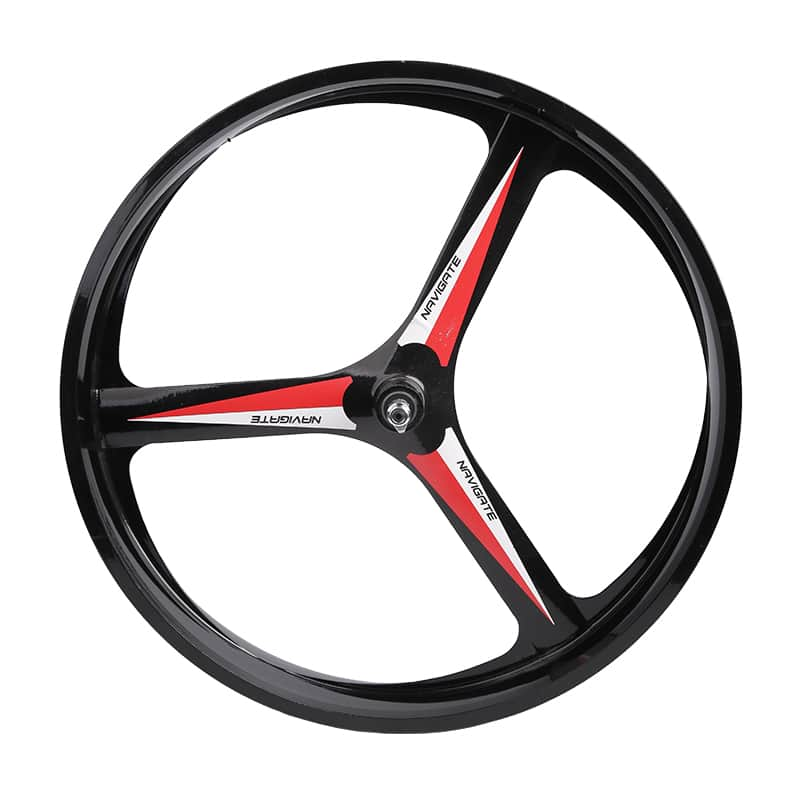

1. What is a Motor Wheel?
Motor Wheel, commonly known as a motor wheel or hub motor in Chinese, is a drive system that directly installs an electric motor in the center of the wheel. It is different from the way traditional vehicles transmit power to the wheels through complex mechanical structures such as engines, gearboxes, drive shafts and differentials, but allows the motor to directly drive the rotation of the wheels.
This design can save a lot of mechanical transmission parts, make the vehicle structure more simple and compact, reduce the weight of the whole vehicle, reduce mechanical losses, and improve the overall transmission efficiency. At the same time, this technology is particularly suitable for light and medium-sized vehicles such as electric bicycles, electric motorcycles and electric vehicles, and promotes the innovation and application of new energy vehicle technology.
2. Working principle of Motor Wheel
Conversion of electrical energy into mechanical energy
The motor in the Motor Wheel is usually a brushless DC motor (BLDC) or a permanent magnet synchronous motor (PMSM). When the battery supplies power to the motor through the electronic control system, current flows through the stator winding to generate a rotating magnetic field. This magnetic field interacts with the permanent magnets on the rotor to generate mechanical torque.
Interaction between magnetic field and rotor
The rotor is usually made of high-strength permanent magnetic material and installed at the center of the wheel axis. When the rotating magnetic field generated by the stator winding acts on the rotor, the rotor will be attracted by the magnetic force and rotate with it, thereby driving the wheel to rotate. This process is very efficient because the motor directly drives the wheel, avoiding the energy loss in traditional mechanical transmission.
Torque directly drives the wheel
Traditional vehicles need to transmit power through multiple mechanisms such as drive shafts and gearboxes, which have mechanical friction and efficiency losses. The Motor Wheel design directly installs the motor inside the wheel, and the torque of the motor is directly converted into the rotational power of the wheel, greatly improving the power transmission efficiency and response speed.
Control system adjusts speed and torque
The motor controller adjusts the amplitude and frequency of the supply current in real time according to the acceleration and deceleration requirements of the vehicle. By precisely controlling the speed and torque of the motor, the smooth start, acceleration and braking of the vehicle are guaranteed. At the same time, regenerative braking can be achieved, and the braking energy can be fed back to the battery to improve the endurance.

3. The structure of the Motor Wheel
Rotor
The rotor is the rotating part of the motor, usually made of high-performance permanent magnet materials such as neodymium iron boron. These permanent magnets produce a stable and strong magnetic field, which is the key to the motor's torque generation. The rotor is fixed to the wheel axis and rotates with the drive of the motor, directly driving the wheel to rotate.
Stator
The stator is a fixed part installed inside the wheel hub. The stator consists of an iron core and a winding coil. After power is turned on, the stator winding generates a rotating magnetic field, which interacts with the rotor magnetic field to generate driving force. The stator design requires precision and the windings are evenly arranged to ensure a stable and efficient magnetic field.
Bearing system
Bearings are key mechanical components that support the normal rotation of the rotor and wheels. High-quality bearings can reduce friction, ensure the stable operation of the rotor and the hub, and withstand the axial and radial forces generated by the vehicle during driving, ensuring the durability and reliability of the drive system.
Hub
The hub not only carries the motor components, but also bears the mechanical load of the wheel. It is the basic structure for tire installation. The hub must have good mechanical strength and corrosion resistance, and also provide an effective heat dissipation channel for the motor to prevent the motor from overheating.
Sensors and control units
In order to achieve precise control, the Motor Wheel is equipped with position sensors (such as Hall effect sensors) and temperature sensors. The position sensor is used to detect the real-time angle and speed of the rotor and feed it back to the motor controller, which adjusts the current phase and amplitude accordingly to achieve precise speed regulation. The temperature sensor protects the motor from overheating and damage.
4. Advantages of Motor Wheel
Compact structure and space saving: the complex transmission system is eliminated, the motor and the wheel are combined into one, and the volume of the whole vehicle is reduced.
Reducing mechanical transmission loss and improving efficiency: friction and energy loss are reduced by eliminating intermediate links such as transmission chains and gears.
Simple maintenance, no need to lubricate chains or gears: reduce wear and maintenance costs of mechanical parts.
Fast response and direct power transmission: short acceleration and braking response time, more sensitive driving experience.
Easy to achieve intelligent control and regenerative braking: efficient energy management is achieved through electronic control systems to improve endurance performance.
5. Application areas
Motor Wheel is widely used in:
Electric bicycles and electric motorcycles: light, easy to install, high efficiency, and improve the experience of short-distance travel in cities.
Electric vehicles: especially urban micro vehicles, simplify the structure and improve power response.
Industrial automation equipment: small robots, AGV (automatic guided vehicles) and other fields, because they are efficient and compact.
Intelligent mobile devices: such as electric scooters, electric wheelchairs, etc., are easy to integrate and control.